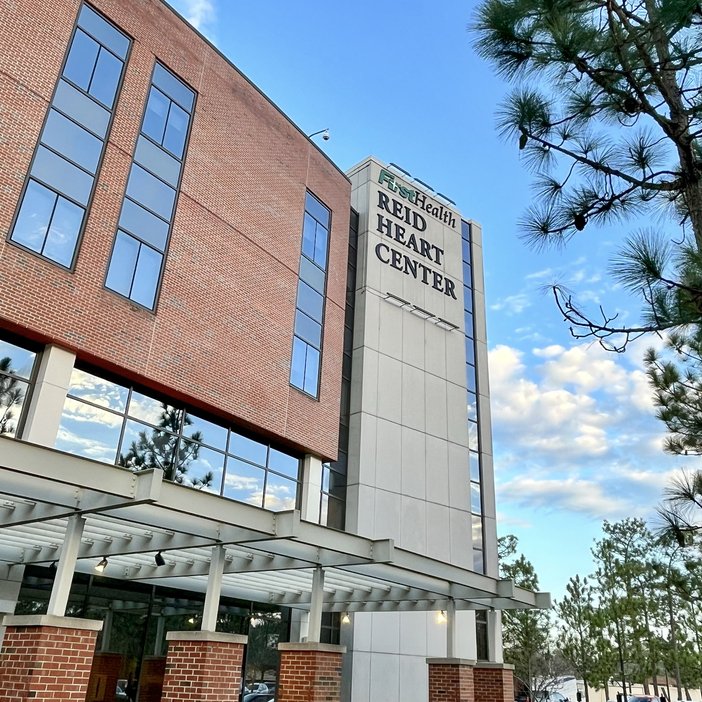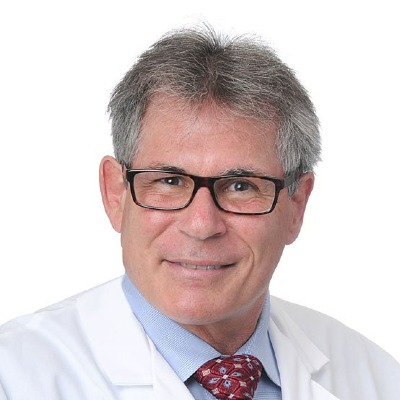 PINEHURST, N.C. - On August 13, 2023, FirstHealth of the Carolinas celebrates the 30th anniversary of the region's first coronary artery stent procedure. FirstHealth interventional cardiologist Scott Denardo, M.D., explains that first procedure as an experience comparable in certain regards to the Wright Brothers' first airplane flight at Kitty Hawk. It also helped launch FirstHealth's reputation as a state and national health care leader.
PINEHURST, N.C. - On August 13, 2023, FirstHealth of the Carolinas celebrates the 30th anniversary of the region's first coronary artery stent procedure. FirstHealth interventional cardiologist Scott Denardo, M.D., explains that first procedure as an experience comparable in certain regards to the Wright Brothers' first airplane flight at Kitty Hawk. It also helped launch FirstHealth's reputation as a state and national health care leader.
An Inoperable, Terminal Situation
In 1993, a 53-year-old woman from Hamlet had a vexing, deathly problem.
Years before, the arteries to her heart (coronary arteries) were blocked, limiting blood flow. As a result, she had chest pain, fatigue and shortness of breath. Her heart surgeon recommended and later performed coronary artery bypass grafting (heart bypass). In this procedure, the surgeon takes a piece of normal vessel (for grafting) from the patient's body, usually a vein from the leg or an artery from the arm or chest. Using open-heart surgery, the surgeon secures one end of the graft above the blockage and the other end below, "bypassing" the blockage and creating a new route for blood flow. The bypass surgery provided her relief for many years.
Eventually, one critical vein graft and additional arteries became blocked, causing more chest pain, fatigue and shortness of breath. Medicine didn't help, and another open-heart bypass surgery wasn't possible. In 1993, heart surgeons at Duke University Medical Center determined she was inoperable and would likely pass away within six to 12 months due to the blocked vein graft and other blockages.
The Duke University heart surgeons referred her to the medical center's interventional cardiology team. Interventional cardiology is a specialized branch of heart care that, instead of open-heart surgery, uses a catheter (a tiny hollow tube through which doctors can inject x-ray dye and transport miniaturized equipment) to visualize and repair cardiovascular problems, including blocked arteries and bypass grafts. The interventional cardiologist advances the catheters through a small incision in the leg or wrist to the vessel of concern, watching with x-ray equipment called fluoroscopy.
 A New Procedure to Repair the Irreparable
A New Procedure to Repair the Irreparable
In 1992, then-33-year-old cardiologist Dr. Scott Denardo was a fellow in training for interventional cardiology at Scripps Clinic and Research Foundation in La Jolla, California. It was one of the nation's top programs, dedicated to exploring new devices to fix blocked blood vessels. While there, he first learned to perform coronary angioplasty. In this minimally invasive procedure, interventional cardiologists insert a catheter equipped with a small balloon into the blocked coronary artery. Inflating the balloon opens the artery and reestablishes normal blood flow.
While balloon angioplasty helped many patients then (and still does today), there were some patients whose coronary arteries got blocked again or even tore during the procedure. Researchers wanted to find a way to stabilize the artery after unblocking it, repair any tears and lessen the chance of the blockage returning. That led Richard Schatz, M.D., and Julio Palmaz, M.D., to develop the coronary stent: a tiny, flexible, surgical-grade stainless steel mesh cylinder mounted on an uninflated balloon. When the interventionalist inflates the balloon at the site of the blockage, the stent opens along with it and deploys into the vessel wall. After deflating and removing the balloon, the stent stays and acts as a scaffold to keep the vessel open.
At that time, the only stents approved by the U.S. Food and Drug Administration (FDA) were designed by Dr. Palmaz for blocked bile (biliary) ducts in the gallbladder. At Scripps, Dr. Denardo learned from his mentors, Dr. Schatz, and Paul Teirstein, M.D., how to use the smallest Palmaz biliary stent to keep larger coronary arteries and bypass grafts open.
Increasing interest in coronary stents led to clinical trials to evaluate the safety and effectiveness of the new procedure using the Palmaz-Schatz coronary stent. In a clinical trial, patients—who often have exhausted other treatments—volunteer to undergo an emerging procedure or medication. While the immediate goal is to help clinical trial participants in particular, the collective results of clinical trials advance medical knowledge as a whole.
After completing his fellowship in June 1993, Dr. Denardo came to Moore Regional Hospital (now FirstHealth Moore Regional Hospital) in Pinehurst as its newest interventional cardiologist, joining David Cowherd, M.D., and Joseph Parrish, M.D.
A Fortuitous Fit
The ailing heart patient from Hamlet was sent to Dr. Denardo, the region's only interventional cardiologist trained in a new procedure that might help her.
The smallest biliary stent in 1993 fit into a space no smaller than 4 millimeters in diameter. Most coronary arteries are 3 to 4 mm in diameter, about the size of a drinking straw. Therefore, only select patients were candidates for the new heart procedure.
Providence prevailed, as the patient's blocked vein graft was just over 4 millimeters. Moore Regional's cardiologists evaluated her as a team and advised her to proceed using the FDA-approved device (biliary stent) for a non-FDA-approved indication (fix blocked blood vessel). They told her she could have the procedure done at Moore Regional, and she agreed.
Like the Wright Brothers’ First Flight
The surgery date was Friday, August 13, 1993. "I'm not superstitious, but that still rattled me from the get-go," Dr. Denardo reflected. The team scheduled the start time for 1 p.m., ensuring that Dr. Denardo's California mentors were available for a potential emergency phone consultation starting at 10 a.m. Pacific time.
Dr. Denardo and the hospital's highly trained catheterization lab staff concluded the procedure at roughly 5 p.m. No emergency calls to California were needed.
"I liken that first stent procedure to the Wright Brothers' first flight at Kitty Hawk," Dr. Denardo explained about the inaugural procedure at Moore Regional Hospital. "The bulky equipment was technically very challenging to work with in the coronary circulation. But we felt that we were introducing a new procedure or technology that would, we hoped, alleviate this patient's symptoms, provide her with a longer life, and hopefully help more patients after her. We knew people in the Sandhills (and the country) needed this technology." However, just like at Kitty Hawk, there was a small but real chance for creating serious problems.
Friday the 13th and bulky equipment aside, the new procedure worked, and the patient had much less pain and shortness of breath. She required another biliary stent a few months later, but she enjoyed a good quality of life for about seven years, eventually succumbing to pancreatic cancer.
Word traveled fast, and Moore Regional Hospital became a hub for the bypass graft coronary stenting procedure using biliary stents. Patients traveled to Pinehurst from Virginia, West Virginia, Tennessee, South Carolina, Georgia and Florida for the procedure. Dr. Denardo initially required that the patients stay in the Pinehurst area for one to two weeks after their biliary stent procedures so he could monitor for complications. He noticed that most patients chose to conduct their cardiac rehabilitation at the local golf courses, an unintended benefit of heart care in the Sandhills.
Drs. Schatz, Teirstein, Denardo and other interventional cardiologists worldwide whose patients participated in the U.S. coronary stenting clinical trial submitted anonymous outcome data to the FDA, who officially approved the Palmaz-Schatz coronary stent in late 1994, opening treatment options for more heart patients nationwide soon after.
Pioneering Next-Level Cardiovascular Care in the Sandhills
Dr. Denardo reports that coronary artery stenting is commonplace today, as he jests with patients, "You can probably get a coronary stent put in down at the Shell [gas] station." The early procedures took four hours and required a five-day post-procedure hospital stay. In contrast, today's coronary stent procedures are usually completed in one to two hours, and most patients go home the same day after a couple of hours for rest and observation. Dr. Denardo added that the procedure's success rate is high, and complications are very few—but can be serious.
"Dr. Denardo and other physicians at FirstHealth laid the groundwork for our community health care system to offer innovative treatments usually reserved for university-based centers," said FirstHealth CEO Mickey Foster. "Many people in the Sandhills don't know that they can receive cutting-edge care close to home."
Reid Heart Center on Moore Regional's campus is the region's first community-based, nonacademic heart hospital. Under one roof are FirstHealth's cardiothoracic surgery program, FirstHealth Valve Clinic, FirstHealth Heart Failure Clinic and one of FirstHealth's many cardiology practices in the region.
In recent years, FirstHealth has introduced numerous minimally invasive cardiovascular treatments to the Sandhills, including transcatheter aortic valve replacement (TAVR) and transcatheter mitral valve repair (TMVr) using the MitraClip™ device to fix faulty heart valves. The WATCHMAN™ device helps some people with atrial fibrillation who are unable to take anticoagulation medications to prevent blood clots that can lead to a stroke. The CardioMEMS™ device allows doctors to remotely monitor potentially dangerous lung fluid pressures of people with heart failure.
FirstHealth's innovations in cardiovascular care, cancer care and other fields contribute to the health care system's state and national rankings and awards. FirstHealth Moore Regional Hospital was named to the Fortune/Merative 100 Top Hospitals list for the second consecutive year. Moore Regional is the only hospital in North Carolina to make the 100 Top Hospitals list. Additionally, FirstHealth Moore Regional Hospital, including its Hoke and Richmond campuses, was recognized as one of the top hospitals in North Carolina by U.S. News & World Report. Business North Carolina named Moore Regional the state's third-best hospital, tying with Duke University Hospital and UNC Hospitals.
Just as the Wright Brothers' first flight eventually led to outer space travel, the first coronary stent at Moore Regional Hospital led to innovations that helped people in the Sandhills receive more world-class cardiovascular care close to home.